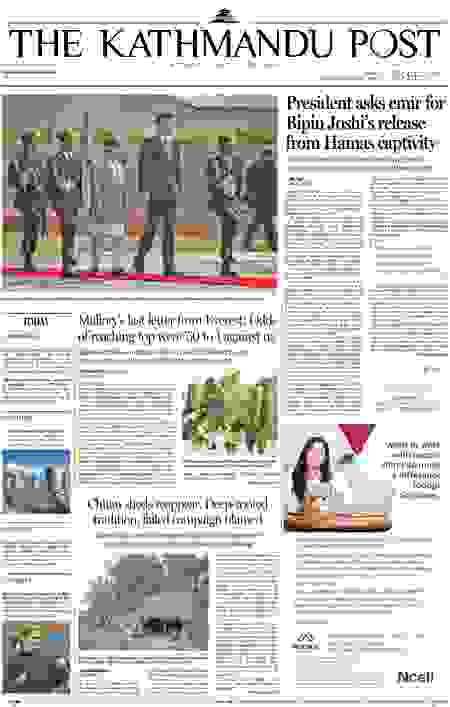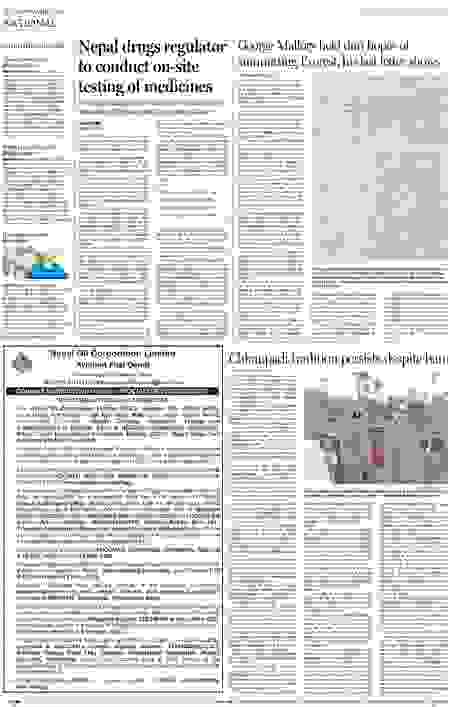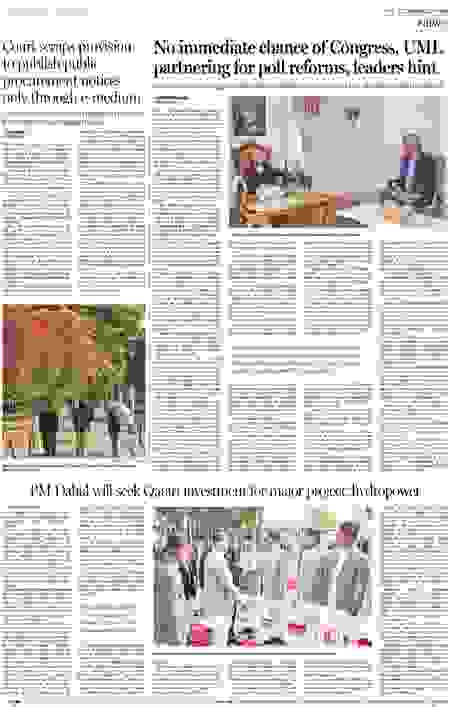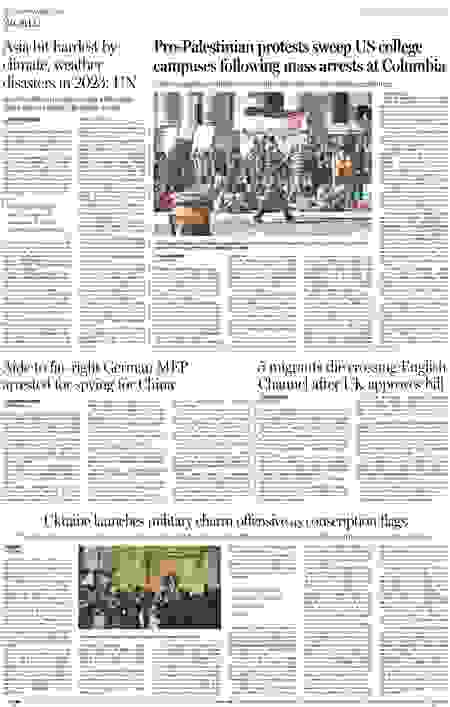HOME PAGE
Mallory’s last letter from Everest: Odds of reaching top were ‘50 to 1 against us’
Mallory and Irvine were last seen alive on June 8, 1924 when they were said to be still going strong some 900 feet beneath the summit.
- BRIAN MELLEY,ASSOCIATED PRESS
Los Angeles,
In his final letter to his wife before he vanished on Mount Everest a century ago, George Mallory tried to ease her worries even as he said his chances of reaching the world’s highest peak were “50 to 1 against us”.
The letter, digitised for the first time and published online on Monday by his Cambridge University alma mater, expressed a mix of optimism, exhaustion and the difficulties his expedition encountered on their quest to be the first party to conquer the peak.
“Darling I wish you the best I can—that your anxiety will be at an end before you get this—with the best news,” he wrote to Ruth Mallory on May 27, 1924 from Camp I. “It is 50 to 1 against us but we’ll have a whack yet & do ourselves proud.”
It remains a mystery whether Mallory, who once famously said he wanted to conquer Everest “because it’s there”, and climbing partner Andrew Irvine reached the summit and died on the way down or never made it that far. Mallory’s body was found 75 years later far below the peak, but Irvine’s has never been located.
The first documented ascent came nearly three decades later when New Zealander Edmund Hillary and Nepal’s Sherpa Tenzing Norgay scaled the mountain on May 29, 1953. Magdalene College posted the letters online to mark the centenary of Mallory’s ill-fated attempt to stand atop the world.
The collection, which had previously been available to researchers, also includes letters he wrote from the battlefront in World War I and correspondence he received from others, including his wife.
The only surviving letter his wife wrote from England during the expedition was sent as his party sailed toward Bombay. It recounts a recent snowstorm, how her bank account was overdrawn and how she fell off a ladder before telling him how much she missed him.
“I know I have rather often been cross and not nice and I am very sorry but the bottom reason has nearly always been because I was unhappy at getting so little of you,” Ruth Mallory wrote on March 3, 1924. “I know it is pretty stupid to spoil the times I do have you for those when I don’t.”
In his final six-page correspondence to his wife, addressed to “My dearest Ruth,” George Mallory speaks of trials and triumphs as the party slowly made its way up the mountain, setting up higher camps and then retreating to lower elevation to recover.
“This has been a bad time altogether,” Mallory wrote 12 days before he was last seen alive. “I look back on tremendous efforts & exhaustion & dismal looking out of a tent door and onto a world of snow & vanishing hopes — & yet, & yet, & yet there have been a good many things to set on the other side.”
Mallory said he had a nagging cough “fit to tear one’s guts” that left him sleepless and made climbing difficult. He described a near-death plunge into a crevasse when he failed to detect it beneath a blanket of snow.
“In I went with the snow tumbling all around me, down luckily only about 10 feet before I fetched up half-blind & breathless to find myself most precariously supported only by my ice axe somehow caught across the crevasse & still held in my right hand,” he said. “Below was a very unpleasant black hole.”
Mallory said only one member of the party remained “plum fit” and they planned to rest up for two days before pushing for the summit, which was expected to take six days.
Mallory and Irvine were last seen alive June 8, 1924 when they were said to be still going strong some 900 feet (274 metres) beneath the 29,035 feet (8,850 metres) summit. Mallory’s body was found at 26,700 feet (8,138 metres).
A group of mountaineers who tried in 2007 to reconstruct Mallory’s ascent were unable to determine if the pair made it to the top.
“I still believe the possibility is there they made it to the top, but it is very unlikely,” said Conrad Anker, who participated in a documentary recreating the climb and who had discovered Mallory’s body in 1999.
In Mallory’s final letter to his wife, he says, “the candle is burning out & I must stop.” He signs off: “Great love to you. Ever your loving, George.”
HOME PAGE
President asks emir for Bipin Joshi’s release from Hamas captivity
The Gulf emirate of Qatar is keen on diversifying areas of cooperation with Nepal and investing in hydropower projects.
- ANIL GIRI
Kathmandu,
Qatar Emir Sheikh Tamim bin Hamad Al Thani arrived in Kathmandu on Tuesday afternoon on a two-day state visit in what is the most high-profile visit from the emirate to Nepal since the two countries established diplomatic relations in 1977.
Al Thani had arrived at the invitation of President Ramchandra Paudel, who welcomed the guest at the Tribhuvan International Airport upon his arrival from Dhaka, Bangladesh. Vice President Ramsahay Prasad Yadav, Speaker Dev Raj Ghimire, Chairman of the National Assembly Narayan Dahal, ministers and heads of the security agencies were present at the special function organised at the airport upon the emir’s arrival, a statement issued by the Office of the President said.
Al Thani is the highest-ranking head of state visiting Nepal from the West Asia or Gulf region.
After the ceremony, the emir left for Sheetal Niwas for a courtesy meeting with President Paudel. The government declared a public holiday on Tuesday in honour of the state visit by the emir. Heavy security has been deployed in Kathmandu for the safety of the state guest. Nepal Army Lieutenant General Ashok Sigdel is leading the security deployment that comprises security personnel from the Nepal Army, the Armed Police Force, the Nepal Police and the National Intelligence Department, said a senior security official.
Upon the emir’s arrival at Sheetal Niwas, he was welcomed by President Paudel. According to the Office of the President, besides President Paudel, Deputy Prime Minister and Minister for Foreign Affairs Narayan Kaji Shrestha, Minister for Energy and Water Resources Shakti Basnet, Foreign Secretary Sewa Lamsal, Secretary at President’s Office Dilliram Poudel, as well as advisers to President Poudel, among others, were present at the meeting.
President Paudel appealed to the emir for his support and intervention in securing a safe release of Bipin Joshi, who is believed to be in Hamas captivity following their October 7 attack on Israel. Nepal has made repeated requests to Qatar and other nations and international humanitarian organisations to help with Joshi’s release.
Responding to the President’s request, the emir assured that he would try his best to secure Joshi’s safe release, Suresh Chalise, foreign relations adviser to President Paudel, told the Post.
“Joshi’s safe release is one of our prime concerns, and the President asked for the emir’s support in securing it,” Kiran Pokhrel, press adviser to President Poudel, told the Post.
Qatar maintains good relations with Palestine and Hamas and has been working to broker a deal to end the fighting between Hamas and Israel.
The National Human Rights Commission also had requested Qatar’s Human Rights Committee to take the initiative to locate Joshi. The commission made the request in writing and also during face-to-face meetings with the officials from the Qatari committee, according to Surya Dhungel, a commissioner at the constitutional human rights watchdog.
In the meeting with President Paudel, the emir vowed to boost bilateral engagements with Nepal and gradually increase investments, according to Chalise. “We will diversify the socio-economic support provided to Nepal,” Chalise quoted the emir as saying during the meeting with the President.
The Qatari side showed keen interest in increasing investment in Nepal’s hydropower sector, according to Chalise.
During the meeting, President Paudel praised Qatar’s role in maintaining global peace, particularly in the West Asia region. The emir praised the role of Nepali nationals living and working in Qatar for their contribution in building infrastructure of Qatar and for their continued work even during the Covid pandemic.
According to the Office of the President, Paudel and Al Thani discussed protecting mountains, water resources conservation and climate change.
President Paudel stressed the need for collaboration between Nepal and Qatar in order to mitigate adverse effects of climate change, protect mountains, save water resources and maintain environmental balance, according to a statement issued by the Office of the President.
“The common challenge of the present world is how to save the earth from the adverse effect of climate change, how to protect the mountains, sources of water and how to save the environment. This is the issue of human existence and particularly developing countries should be sensitive towards this issue. All the countries of this world should come together on these pressing issues,” Paudel said at the meeting, according to the statement.
Paudel expressed his concerns about the escalating conflict in the Middle East and told the emir that Nepal is in favour of peace while praising the role being played by Qatar as a peace broker, said Kiran Pokhrel, press adviser to the President.
In response, the emir said the entire world has been impacted by climate change and countries should work together to adhere to the agreements and accords to mitigate its adverse effects.
“If all countries adhere to past agreements in mitigating the adverse effect of climate change, it will give positive results and create a happier situation,” the statement issued in Nepali by the Office of the President said, quoting the emir.
The emir stated that his visit would be fruitful in exploring more avenues of cooperation, and further strengthening bilateral ties between Nepal and Qatar, said the statement issued by
the office.
The emir also praised the contribution of Nepali citizens in the development of Qatar and thanked President Paudel for their efforts.
As many as 400,000 Nepalis are currently living and working in Qatar.
On Wednesday, Prime Minister Dahal and Emir of Qatar will hold delegation level talks where the two sides will explore, discuss and reach some understanding in areas like hydropower, agriculture and tourism.
The prime minister and Emir Al Thani are expected to discuss several issues of bilateral interest including inviting Qatari investments in various sectors of Nepal, and renewal of labour agreement, among other things, according to officials.
The prime minister is likely to make a request for Qatari investment for a big project, either the construction of an international airport or a hydropower project, according to officials privy to the meeting’s agenda.
During Tuesday’s meeting, Paudel stated that Nepal and Qatar should work together in areas like trade, tourism, and investment, and reminded the role of Nepali migrant workers in Qatar’s prosperity.
After the delegation level talks, President Paudel hosted a state banquet in the honour of the Qatari Emir and the visiting delegation.
From the Qatari side, Sheikh Saoud Bin Abdulrahman Al Thani, the chief of the Amiri Diwan, Jassim bin Saif Al Sultani, Minister of Transport, Sheikh Mohammed bin Hamad bin Qassim Al Thani,
Minister of Commerce and Industry, Soltan bin Saad Al Muraikhi, State Minister for Foreign Affairs, Saad bin Nasser Kabbi, Director of Studies and Research Department of Amiri Diwan, Sheikh Faisal bin Thani Al Thani, Chief of Asia and Africa Investments of Qatar Investment Authority (QIA), Yousef Sultan Laram, Director of Asian Affairs Department of Ministry of Foreign Affairs are accompanying
the Emir.
Similarly, Sultan Bin Ghanim Alhodaifi, chief of Emir’s private affairs office, Talal bin Almas Al Sulaiti, assistant director of the Amiri Ceremonies department and Mansour Faleh Al Hajri, personal assistant of Amir are accompanying the Qatari Emir on the visit.
Emir Al Thani arrived in Kathmandu after completing a state visit to Bangladesh leading a delegation of over 150 people, according to a security official in Kathmandu.
Besides his special private jet, three other planes carrying members of the delegation, officials, members of the business communities and security personnel also landed in Kathmandu on Tuesday afternoon.
Al Thani is scheduled to depart on Wednesday afternoon following delegation level talks with Prime Minister Dahal and a luncheon hosted by the prime minister in honour of the emir and his delegation.
HOME PAGE
Chhau sheds reappear. Deep-rooted tradition, failed campaign blamed
Four years ago, a one-off campaign was launched by the government to dismantle menstruation sheds, but there was no follow-up.
- MENUKA DHUNGANA
ACHHAM,
In ward 5 of Dhakari Rural Municipality in Achham district, a 23-year-old woman lives in a chhau shed outside her house for three days every month during her menstrual period.
“Four years ago, with the help of security personnel and all three levels of government, a campaign was launched to demolish chhau goth [menstruation sheds] and put an end to this deep-rooted practice,” said Thapa.
“After the authorities demolished the sheds, I started staying in a room at my house during my periods, but after a couple of months, I was compelled to stay in a tarpaulin tent outside the house every month. Later, everyone in our village erected chhau sheds again, and currently all the girls of the village live in sheds during three days of menstruation,” Thapa added.
Despite various functions and campaigns organised by the government and international and local development organisations, the chhaupadi tradition—an outdated social practice in which menstruating girls, women, and postpartum mothers are deemed impure and banished into
seclusion for three days—still prevails in various districts of the Sudurpaschim and Karnali provinces.
The civil and criminal codes enforced in 2017 have criminalised chhaupadi.
The practice of chhaupadi is not only discriminatory against women, but is also life-threatening, as seen from reports of girls and women dying in chhau sheds due to cold, suffocation, snakebites, and wildlife attacks surfacing frequently.
In Achham, the sheds that were demolished four years ago have started to be built again, and women have resumed living in them during menstruation due to lack of attention from local units and government agencies.
Four years ago, Parbati Budha Rawat, a 20-year-old woman from Siddheshwari in ward 3 of Sanphebagar Municipality of the district, died in a chhau shed due to asphyxiation caused by a woodfire she had lit to keep warm before going to bed.
According to the police, after Parbati’s death, her brother-in-law Chhatra Rawat, was arrested by the police after finding out he had forced her to live in the shed during her menstruation. But the police failed to build a strong case against him because nobody from the family or outside registered any complaint.
Based on the police report, Chhatra was presented at the Achham District Court and was only sentenced to serve 45 days in prison for forcing the victim to live in a shed, said police.
Clause 168 (3) of the Civil and Criminal Code provisions three-month jail and a fine of Rs3,000 against anyone found guilty of forcing a woman to live in a chhau shed during menstruation. The punishment is more severe for those holding public positions.
After the formation of local governments under the federal structure in 2017, the trend of destroying chhau sheds gained momentum with sporadic campaigns aimed at ridding the villages of menstrual taboos.
On January 22, 2020, the federal Ministry of Home Affairs directed the administration in 19 districts of Sudurpaschim and Karnali provinces to dismantle chhau sheds.
According to the District Administration Office of Achham, under the instruction of the federal Ministry of Home Affairs, more than 10,000 chhau sheds were torn down in 91 wards of ten local units of the district in around a month. Similarly, the local people’s representatives, police, and local residents came forward to support the campaign, but it was later stopped after a couple of months.
Neither the police administration nor the local units gave continuity to the campaign.
Bindu Rawal, deputy chair of Bannigadi Jayagad Rural Municipality, said that currently her office has no plan to dismantle chhau sheds, or monitor them, or conduct any awareness programmes.
“How can we stop such a deep-rooted tradition without coordinated efforts and federal funding? Due to lack of budget the rural municipality is unable to launch any effective programmes to end the practice.” said Rawal.
Meanwhile, Netrakala Devi Shahi, deputy chair of the Dhakari Rural Municipality of the district, said that nobody in her local unit has rebuilt chhau sheds after they were dismantled a few years ago. But some people still send their women to animal sheds during the period of menstruation.
“Women are still living in barns or under tarpaulin tents after the chhau sheds were demolished, and if we take any action about it, it can cause a major dispute in the rural municipality because of their old beliefs,” said Shahi.
According to the officials of other local units in the district, currently, nobody is conducting awareness campaigns or making efforts to tackle the chhaupadi tradition.
Srijana Saud, a 24-year-old woman from ward 3 of Mangalsen Municipality, said until four years ago, due to the fear of the law and legal action, women in the district used to stay at home during their periods, and nobody would force them to live outside.
“But women are returning to sheds, barns, and tents again because the campaign was discontinued. If the campaign had been given continuity, things would have been much better by now,” said Saud. “The provincial and federal governments only seem to show concern about the Chhaupadi issue when a serious incident occurs. Women always suffer in this patriarchal society, especially in the rural areas where getting help from anybody is very hard,” Saud added.
“The monsoon and winter are very difficult for the people living in higher altitudes, and in such harsh weather conditions, women are forced to live outside during menstruation. However, some women willingly go to live in chhau sheds as well due to superstition and old beliefs,” said Shushila Thapa, a women’s rights activist from Sudurpaschim. “This practice can only be stopped if all three governments and government authorities work in coordination. The practice is widely followed in the remote areas of Achham, Doti, Bajura, and Bajhang districts. The government should work continuously in those areas to educate and make people aware until the people themselves put an end to the practice,” said Thapa.
Senior Superintendent of Police Prajwal Maharjan, spokesperson of Sudurpaschim Provincial Police, said that there is not official data on how many women died in chhau sheds, but since the fiscal year 2006-2007, at least 19 women died, and almost all of them were from remote areas.
“Since the fiscal year 2006-7, altogether 14 women died in Achham, two in Doti, and three in Bajura. Even after the tragic deaths, nobody has lodged any complaints, so police could not do anything,” said Maharjan. “We have not conducted any monitoring programme since the last campaign to demolish chhaupadi sheds because we have not received new instructions from higher authorities, agencies, or the local units where the practice continues. Also, police cannot intervene in such matters because that could spark social disputes,” Maharjan added.









